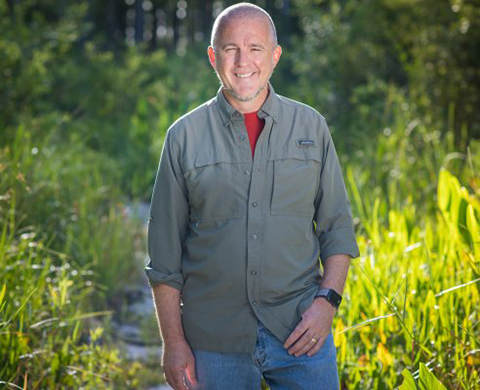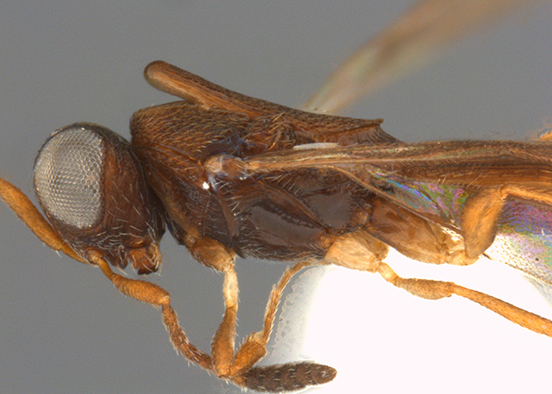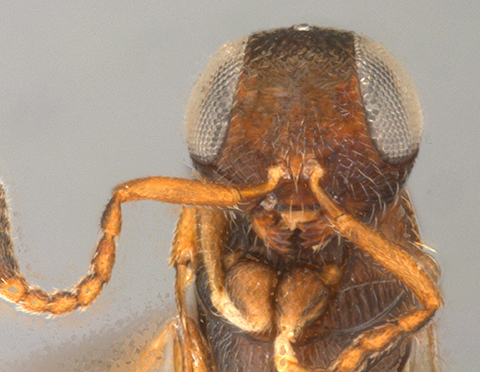If someone named a wasp after you, you might consider it stinging commentary on their feelings about you.
But when Dr. Billy Gunnels found out that a former student had done just that, he was thrilled.

“As a wildlife biologist, I cannot imagine a higher honor,” said the Florida Gulf Coast University associate professor and director of the Office of Scholarly Innovation and Undergraduate Research. “This may not mean much to others, but it was simply the coolest thing anyone could have done for me. Seriously, it still gives me shivers.”
Gunnels was drinking coffee and checking emails early on the morning of Sept. 9 – his 50th birthday – when he opened one from a former student, Zach Lahey (’10, Environmental Studies and Biology).
“I am writing you to let you know that I intend to name a new species of parasitic wasp in your honor: Phoenoteleia gunnelsi, based on a single female specimen from Indonesia,” Lahey wrote.
It was, Gunnels said, the perfect gift for a wasp-loving animal behaviorist.
“I love wasps for a host of reasons,” he said. “They show some of the most creative life histories. The Cuban paper wasp, for example, can live in solitary conditions or as part of groups where they cooperate. Their larvae also feed the adults. The adults capture prey then feed it to the larvae. The larvae presumably digest then regurgitate a liquid diet the adults consume because the adults can’t eat solid food, so they use the offspring as partial digestion tools.”
Other wasps, such as parasitoids, help control populations of unwanted insects, such as agricultural crop pests, without the use of pesticides.
Pretty fascinating, huh?
Well, it is to a biology professor who has been known to have his students act out bee behavior on the university’s Great Lawn, wax lyrical about Amazonian snakes and study the mating behavior of giraffes.

Animals – large and small, those with wings, scales or fur – are endlessly fascinating to him and afford him no end of research projects that he shares with his students.
Wasps, however, are among his favorites.
It’s a passion that Lahey shares. Currently working on his doctoral degree at The Ohio State University, Lahey has been interested in all sorts of animals since he was young, but it was through a job that Gunnels helped him secure that he discovered the world of parasitoid wasps.
He and Gunnels connected when Lahey was an undergraduate taking an animal behavior class.
“I talked to him after class and told him how cool the material was,” Lahey recalled. “We struck up a rapport and that led to him advising my senior project about arthropods on sabal palms on the FGCU campus.”
That, in turn, led to Lahey landing a job with the University of Florida’s nearby research center where he “realized students were getting their master’s degrees at the same facility. I credit him with getting the ball rolling on things. He instilled in me what it’s like to do science.”
So, when Lahey discovered this wasp – one of many undescribed parasitoid wasp species from various parts of the world – he decided to name it for Gunnels.
“In this field you name a species after someone to honor them,” Lahey says.

The wasp – a female and the only one of her species known to exist – has a long protruding horn on its abdomen (the posterior-most part of the insect body), which houses the wasp’s ovipositor, the organ through which it lays eggs. Parasitoid wasps lay eggs in the bodies of other species, such as within the eggs of grasshoppers. The wasp eggs hatch within the host, the wasp larvae consume the contents, and then an adult parasitoid chews through the host’s skin. Just think of the movie “Alien,” but in miniature.
“It’s like a horror story,” Gunnels said. “Insects provide the greatest storylines.”
Lahey is involved in research on parasitic wasps from all over the world.
“It’s a global operation,” he said. “People collect parasitoids from all corners of the globe and most of these specimens are deposited in research institutions, such as museums.”
Insects often find their way to the C.A. Triplehorn Insect Collection at The Ohio State University. Researchers like Lahey then examine them and try to determine if they are members of a known species or if they might be one that’s not yet been identified, like Phoenoteleia gunnelsi. Lahey is the lead author of an article on the wasp genus Phoenoteleia that will appear in a special issue of the Journal of Hymenoptera Research this fall.
Gunnels couldn’t be happier about his former student’s success or the fact that a rare wasp now bears his name.
“Turning 50 is supposed to be a dark day,” he said. “There are only so many living things on the planet. For someone to think that my work deserves that memory, I couldn’t have been more honored or humbled.”